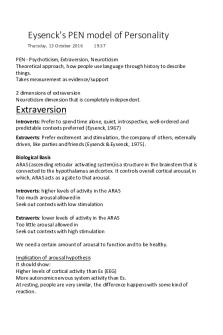Cloninger\'s Biological Model of Personality PDF

| Title | Cloninger\'s Biological Model of Personality |
|---|---|
| Course | Psychology |
| Institution | University of East Anglia |
| Pages | 2 |
| File Size | 77.9 KB |
| File Type | |
| Total Downloads | 46 |
| Total Views | 149 |
Summary
one of the biological models of personality...
Description
Cloninger's Biological Model of Personality Chapter 8 Personality, Individual Differences, and Intelligence Robert Cloninger proposed a psychobiological personality theory, including seven personality dimensions, based on combining findings from a series of family, psychometric, neuropharmacological (drugs on the nervous system) and neuroanatomical studies. At the start, it only had 3 dimensions but has been expanded to include 7. The theory of personality is broken down into 4 temperament domains: 1. 2. 3. 4.
Novelty-seeking Harm avoidance Reward dependence Persistence
And the 3-character domains: 5. Self-directedness 6. Cooperativeness 7. Self-transcendence Like Eysenck and Gray’s theory, these are linked to biological systems and thought to be inherited. The 4 temperaments are independent brain systems aligned to specific nerve cells/fibres that transmit nerve impulses by neurotransmitters. They are chemicals used to relay, amplify, and modulate electrical signals in the brain. Cloninger links our personality to those neurotransmitters that are responsible for activation/inhibition of our behaviour, and the learning/responses to real and perceived rewards and punishments. 1. Novelty-seeking Reflects impulsive behaviour and activation of behaviour – the tendency to like excitement. Thought to be connected to the dopamine neurotransmitter. Dopamine is crucial to the parts of the brain that control our movements and is associated with pleasure. In the frontal lobes (planning, controlling, and executing behaviour), dopamine controls the flow of information from other parts of the brain. 2. Harm avoidance Reflects cautious behaviours – behaviour inhibition to avoid punishment. Harm avoidance is thought to be connected to the serotonin neurotransmitter that is known to modulate mood, emotion, and sleep. 3. Reward dependence Reflects friendliness and a tendency to seek rewards – verbal signals of social approval and positive responses from others. Thought to be connected to noradrenaline/norepinephrine – is a stress hormone that affects the human brain where attention and impulsivity are
controlled. Related to activation of the sympathetic nervous system, which regulates our responses to stress. 4. Persistence Reflects a tendency to persevere in behaviour despite fatigue/frustration. Emerged from the reward dependence dimension. Persistence also represents behaviour maintenance – thought to be connected to norepinephrine. The character traits here contrast to temperaments because they aren’t biological in origin but refer to how individuals understand themselves in the social world. Character traits represent our emotions, habits, goals, and intellectual abilities. They are: 5. Self-directedness Reflects the individual’s own concept of how autonomous one is – people show feelings of self-esteem, integrity, leadership. 6. Cooperativeness Based on the person’s self-concept of how they fit into society – morality, ethics, community, compassion. 7. Self-transcendence Reflects individuals’ self-concept in terms of their common beliefs about mystical experiences – religious faith, spirituality. Although he separated temperament and character traits, the two were thought to interact. Individuals with the same temperament may behave differently because of character development. This model is measured by the Temperament and Character Inventory-Revised (TCI-R) – contains 240 items. Responses are scored on a 5-point scale (5 definitively true). There are links between Cloninger’s model of personality and other models. Novelty-seeking is thought to mirror Eysenck’s extraversion, and harm avoidance Gray’s behavioural inhibition and Eysenck’s neuroticism. Cloninger’s reward dependence system is equivalent to Gray’s behavioural approach system....
Similar Free PDFs

Biological Model OF Addiction
- 26 Pages

Five-Factor Model of Personality
- 2 Pages

Collection OF Biological Samples
- 4 Pages

Biological Basis of Behaviour
- 8 Pages

Biological Etiology of MDD
- 4 Pages
Popular Institutions
- Tinajero National High School - Annex
- Politeknik Caltex Riau
- Yokohama City University
- SGT University
- University of Al-Qadisiyah
- Divine Word College of Vigan
- Techniek College Rotterdam
- Universidade de Santiago
- Universiti Teknologi MARA Cawangan Johor Kampus Pasir Gudang
- Poltekkes Kemenkes Yogyakarta
- Baguio City National High School
- Colegio san marcos
- preparatoria uno
- Centro de Bachillerato Tecnológico Industrial y de Servicios No. 107
- Dalian Maritime University
- Quang Trung Secondary School
- Colegio Tecnológico en Informática
- Corporación Regional de Educación Superior
- Grupo CEDVA
- Dar Al Uloom University
- Centro de Estudios Preuniversitarios de la Universidad Nacional de Ingeniería
- 上智大学
- Aakash International School, Nuna Majara
- San Felipe Neri Catholic School
- Kang Chiao International School - New Taipei City
- Misamis Occidental National High School
- Institución Educativa Escuela Normal Juan Ladrilleros
- Kolehiyo ng Pantukan
- Batanes State College
- Instituto Continental
- Sekolah Menengah Kejuruan Kesehatan Kaltara (Tarakan)
- Colegio de La Inmaculada Concepcion - Cebu










